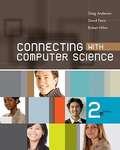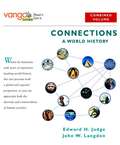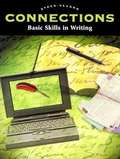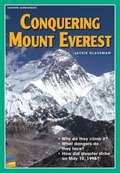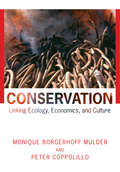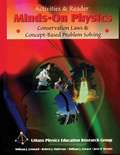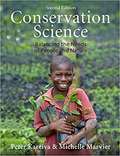- Table View
- List View
Connecting with Computing Science
by Greg Anderson David Ferro Robert HiltonWritten for the beginning computing student, this text engages readers by relating core computer science topics to their industry application. The book is written in a comfortable, informal manner, and light humor is used throughout the text to maintain interest and enhance learning. All chapters contain a multitude of exercises, quizzes, and other opportunities for skill application.
Connections: A Combined Reader and Rhetoric
by Kerry Beckford Donald JonesThis book offers thematic and instructional content in one easy-to-use source. The five instructional chapters present proven practices and fundamental concepts while the five thematic chapters immerse students in multiple perspectives, historical contexts, and contemporary debates. The integrated instructional and thematic chapters of Connections will teach students to excel in their writing courses and across the curriculum.
Connections: A World History
by Edward H. Judge John W. LangdonConnections: A World History focuses on the connections within and between societies, combining a uniquely comprehensive and consistent map program with a strong pedagogical support and a narrative that students will actually read. Written by historians with years of experience teaching world history,Connections presents both a global and regional perspective, so students can appreciate both the diversity and connectedness of human societies. Concise chapters and a clear engaging narrative make the text accessible to a wide range of students. In addition, because students struggle with geography, the book includes significantly more maps than other texts-in most cases twice as many-and great care was taken to make them consistent and exceptionally clear. In each caption, the authors have provided guidance for reading the map and for connecting it to the surrounding text. To further help students succeed, marginal notes highlight major connections for easy review, and pronunciation guides appear after difficult names. Lastly, compelling vignettes introduce the themes of each chapter, concise excerpts from relevant primary sources allow students to hear the voices of the past, and an extensive chapter review section is designed to help students test themselves and succeed in this difficult course.
Connections: English Language Arts (Grade 12, Student Edition)
by Perfection LearningA comprehensive, integrated curriculum created to help students connect with complex texts.
Connections: Basic Skills in Writing
by Steck-VaughnA second chance for your low-level readers having trouble in the content areas. Connections offers subject-specific titles in all the content areas written at reading levels 5-8.
Connections: Basic Skills in Social Studies
by Steck-VaughnA second chance for your low-level readers having trouble in the content areas. Connections offers subject-specific titles in all the content areas written at reading levels 5-8. Designed for independent use. Connections is truly a self-directed program. With its low reading level and straightforward directions, students can measure their own progress with pre-tests and post-tests. Correlation charts are tied to test questions directing them to the precise pages to study for each type of question. <BR>-- Units on the world of work and careers are tied to content areas. Answers and explanations in each book enable students to check their answers and understand the thinking behind each question. Real-life and work graphics content designed for secondary students help them connect academic skills with life and work skills. Reading selections emphasize comprehension, so students can improve reading skills as they gain content knowledge.
Connections Reading Program: Adventuring Grade 3
by Macmillan StaffMacmillan Connections Reading Program textbook
Connections: Writing & Language, High School
by Cynthia Clampitt Larkin Page-Jacobs Carol Francis Jo PitkinNIMAC-sourced textbook
Conoce a los perros de la granja Bedlam (¡Arriba la Lectura!, Read Aloud Module 1 #1)
by Jon KatzNIMAC-sourced textbook
Conquering Mount Everest
by Jackie Glassman Alison AdamsFind out about Mount Everest and the daring people who have tried to reach its summit.
The Conquest of Ainu Lands: Ecology and Culture in Japanese Expansion, 1590-1800
by Brett L. WalkerThis model monograph is the first scholarly study to put the Ainu--the native people living in Ezo, the northernmost island of the Japanese archipelago--at the center of an exploration of Japanese expansion during the seventeenth and eighteenth centuries, the height of the Tokugawa shogunal era. Inspired by "new Western" historians of the United States, Walker positions Ezo not as Japan's northern "frontier" but as a borderland or middle ground. By framing his study between the cultural and ecological worlds of the Ainu before and after two centuries of sustained contact with the Japanese, the author demonstrates with great clarity just how far the Ainu were incorporated into the Japanese political economy and just how much their ceremonial and material life--not to mention disease ecology, medical culture, and their physical environment--had been infiltrated by Japanese cultural artifacts, practices, and epidemiology by the early nineteenth century. Walker takes a fresh and original approach. Rather than presenting a mere juxtaposition of oppression and resistance, he offers a subtle analysis of how material and ecological changes induced by trade with Japan set in motion a reorientation of the whole northern culture and landscape. Using new and little-known material from archives as well as Ainu oral traditions and archaeology, Walker poses an exciting new set of questions and issues that have yet to be approached in so innovative and thorough a fashion.
Conservar los alimentos (¡Arriba la Lectura!, Level U #48)
by Phillip SimpsonNIMAC-sourced textbook
Conservation: Linking Ecology, Economics, and Culture
by Monique Borgerhoff Mulder Peter CoppolilloNearly 90 percent of the earth's land surface is directly affected by human infrastructure and activities, yet less than 5 percent is legally "protected" for biodiversity conservation--and even most large protected areas have people living inside their boundaries. In all but a small fraction of the earth's land area, then, conservation and people must coexist. Conservation is a resource for all those who aim to reconcile biodiversity with human livelihoods. It traces the historical roots of modern conservation thought and practice, and explores current perspectives from evolutionary and community ecology, conservation biology, anthropology, political ecology, economics, and policy. The authors examine a suite of conservation strategies and perspectives from around the world, highlighting the most innovative and promising avenues for future efforts. <p><p> Exploring, highlighting, and bridging gaps between the social and natural sciences as applied in the practice of conservation, this book provides a broad, practically oriented view. It is essential reading for anyone involved in the conservation process--from academic conservation biology to the management of protected areas, rural livelihood development to poverty alleviation, and from community-based natural resource management to national and global policymaking.
Conservation Laws and Concept-Based Problem-Solving (Minds on Physics)
by University of Massachusetts StaffThe activities in this book are designed to get you thinking about and doing physics in a way that is a lot closer to the way professional scientists think about and do science. You will learn by communicating your ideas with your teacher and with other students, and by trying to make sense of the ideas presented in the book.
Conservation Science: Balancing the Needs of People and Nature
by Michelle Marvier Peter KareivaNow is the time for conservation science―a mission-oriented scientific enterprise that seeks to protect nature, including Earth’s animals, plants, and ecosystems, in the face of unprecedented human demands upon the planet. Conservation scientists apply principles from ecology, population genetics, economics, political science, and other natural and social sciences to manage and preserve nature. The focus of this textbook is first and foremost on protecting nature and especially Earth’s biota. It also contains a heavy emphasis on highlighting strategies to better connect the practice of conservation with the needs and priorities of a growing human population. <p><p> Now used at over 150 colleges and universities, Conservation Science is an original and modern approach to conservation. Gretchen Daily (Stanford University) says it well: “Based on unparalleled, firsthand experience, Kareiva and Marvier explore the innovative approaches to conservation being honed around the world today. Their account is rigorous and engaging, with fresh questions, data, and quantitative analysis interwoven with vivid stories of actual conservation practice in the field." <p><p> Conservation Science was primarily written primarily for undergraduates and beginning graduate students who are interested either in academic careers or working in conservation at government agencies, non-governmental organizations, or international institutions.

